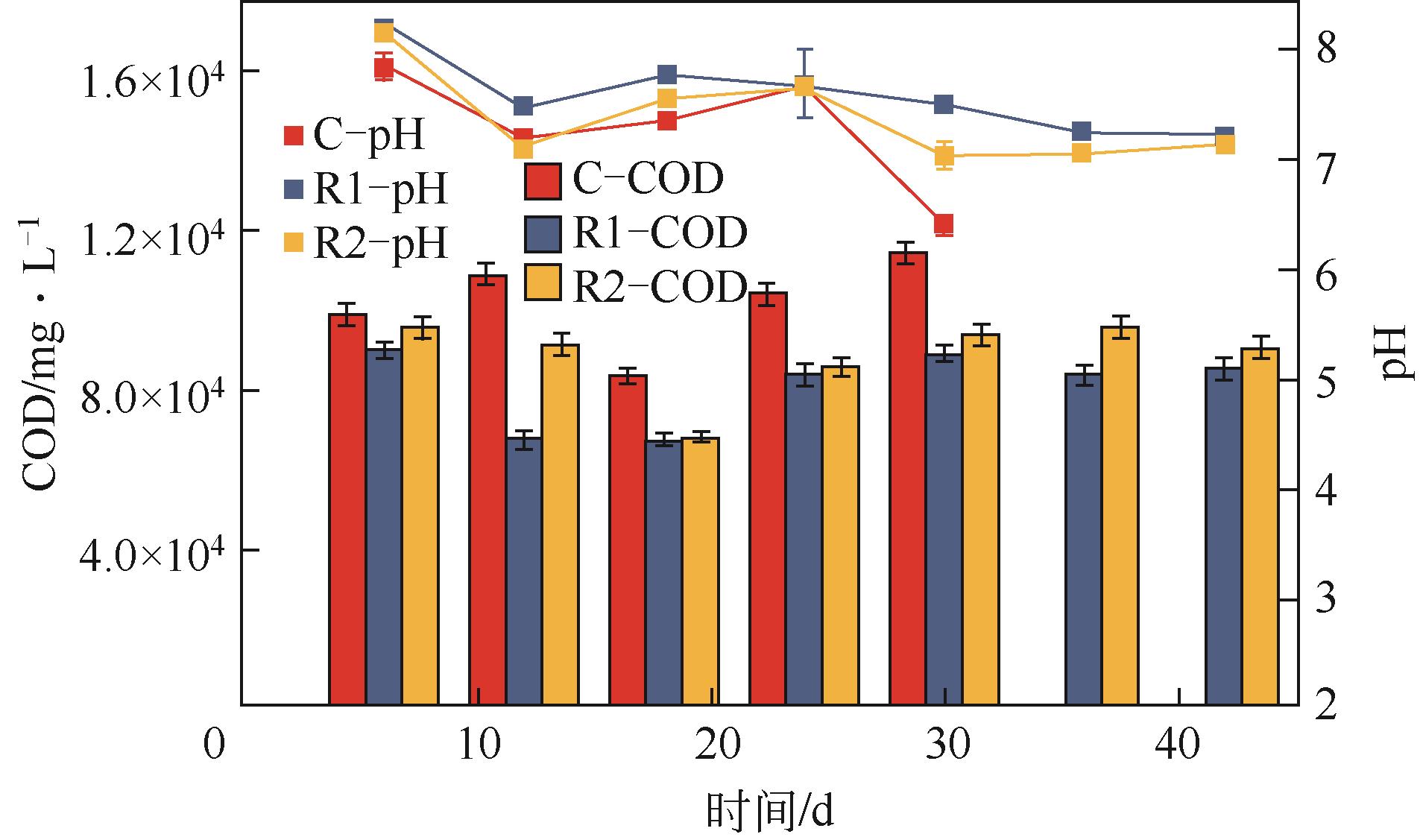| 1 |
EL-FADEL M, SAIKALY P, GHANIMEH S. Startup and stability of thermophilic anaerobic digestion of OFMSW[J]. Critical Reviews in Environmental Science and Technology, 2013, 43(24): 2685-2721.
|
| 2 |
LOHANI S P, WANG S, BERGLAND W H, et al. Modeling temperature effects in anaerobic digestion of domestic wastewater[J]. Water-Energy Nexus, 2018, 1(1): 56-60.
|
| 3 |
MICOLUCCI F, GOTTARDO M, PAVAN P, et al. Pilot scale comparison of single and double-stage thermophilic anaerobic digestion of food waste[J]. Journal of Cleaner Production, 2018, 171: 1376-1385.
|
| 4 |
KJERSTADIUS H, COUR JANSEN J LA, DE VRIEZE J, et al. Hygienization of sludge through anaerobic digestion at 35, 55 and 60℃[J]. Water Science and Technology, 2013, 68(10): 2234-2239.
|
| 5 |
CHEN Y J, HE H J, LIU H Y, et al. Effect of salinity on removal performance and activated sludge characteristics in sequencing batch reactors[J]. Bioresource Technology, 2018, 249: 890-899.
|
| 6 |
ZANDVOORT M H, HULLEBUSCH E D VAN, FERMOSO F G, et al. Trace metals in anaerobic granular sludge reactors: bioavailability and dosing strategies[J]. Engineering in Life Sciences, 2006, 6(3): 293-301.
|
| 7 |
ZHANG J X, QU Y Y, QI Q X, et al. The bio-chemical cycle of iron and the function induced by ZVI addition in anaerobic digestion: a review[J]. Water Research, 2020, 186: 116405.
|
| 8 |
WANG D X, MA W C, HAN H J, et al. Enhanced anaerobic degradation of Fischer-Tropsch wastewater by integrated UASB system with Fe-C micro-electrolysis assisted[J]. Chemosphere, 2016, 164: 14-24.
|
| 9 |
ZHAO Z S, ZHANG Y B, LI Y, et al. Comparing the mechanisms of ZVI and Fe3O4 for promoting waste-activated sludge digestion[J]. Water Research, 2018, 144: 126-133.
|
| 10 |
QI Q X, SUN C, ZHANG J X, et al. Internal enhancement mechanism of biochar with graphene structure in anaerobic digestion: the bioavailability of trace elements and potential direct interspecies electron transfer[J]. Chemical Engineering Journal, 2021, 406: 126833.
|
| 11 |
WEI W, CAI Z Q, FU J, et al. Zero valent iron enhances methane production from primary sludge in anaerobic digestion[J]. Chemical Engineering Journal, 2018, 351: 1159-1165.
|
| 12 |
ZHANG J X, ZHANG Y B, QUAN X. Electricity assisted anaerobic treatment of salinity wastewater and its effects on microbial communities[J]. Water Research, 2012, 46(11): 3535-3543.
|
| 13 |
CHEN D Y, WANG Z M, ZHANG M L, et al. Effect of increasing salinity and low C/N ratio on the performance and microbial community of a sequencing batch reactor[J]. Environmental Technology, 2021, 42(8): 1213-1224.
|
| 14 |
FEIJOO G, SOTO M, MÉNDEZ R, et al. Sodium inhibition in the anaerobic digestion process: antagonism and adaptation phenomena[J]. Enzyme and Microbial Technology, 1995, 17(2): 180-188.
|
| 15 |
IBARRA-VILLARREAL A L, GÁNDARA-LEDEZMA A, GODOY-FLORES A D, et al. Salt-tolerant Bacillus species as a promising strategy to mitigate the salinity stress in wheat (Triticum turgidum subsp. durum)[J]. Journal of Arid Environments, 2021, 186: 104399.
|
| 16 |
MOERTELMAIER C, LI C R, WINTER J, et al. Fatty acid metabolism and population dynamics in a wet biowaste digester during re-start after revision[J]. Bioresource Technology, 2014, 166: 479-484.
|
| 17 |
WANG F, YI W M, ZHANG D L, et al. Anaerobic co-digestion of corn stover and wastewater from hydrothermal carbonation[J]. Bioresource Technology, 2020, 315: 123788.
|
| 18 |
TITILADUNAYO I F, MCDONALD A G, FAPETU O P. Effect of temperature on biochar product yield from selected lignocellulosic biomass in a pyrolysis process[J]. Waste and Biomass Valorization, 2012, 3(3): 311-318.
|
| 19 |
LIU C Q, SUN D Z, ZHAO Z Q, et al. Methanothrix enhances biogas upgrading in microbial electrolysis cell via direct electron transfer[J]. Bioresource Technology, 2019, 291: 121877.
|
| 20 |
HOLMES D E, SHRESTHA P M, WALKER D J F, et al. Metatranscriptomic evidence for direct interspecies electron transfer between geobacter and methanothrix species in methanogenic rice paddy soils[J]. Applied and Environmental Microbiology, 2017, 83(9): e00223-17.
|
| 21 |
ZHANG W, ZHANG F, LI Y X, et al. No difference in inhibition among free acids of acetate, propionate and butyrate on hydrogenotrophic methanogen of Methanobacterium formicicum [J]. Bioresource Technology, 2019, 294: 122237.
|
| 22 |
ZHAO Z Q, ZHANG Y B, HOLMES D E, et al. Potential enhancement of direct interspecies electron transfer for syntrophic metabolism of propionate and butyrate with biochar in up-flow anaerobic sludge blanket reactors[J]. Bioresource Technology, 2016, 209: 148-156.
|
| 23 |
DAI K, ZHANG W, ZENG R J, et al. Production of chemicals in thermophilic mixed culture fermentation: mechanism and strategy[J]. Critical Reviews in Environmental Science and Technology, 2020, 50(1): 1-30.
|
| 24 |
WEI J, HAO X D, LOOSDRECHT M C M VAN, et al. Feasibility analysis of anaerobic digestion of excess sludge enhanced by iron: a review[J]. Renewable and Sustainable Energy Reviews, 2018, 89: 16-26.
|
| 25 |
GUO J H, PENG Y Z, NI B J, et al. Dissecting microbial community structure and methane-producing pathways of a full-scale anaerobic reactor digesting activated sludge from wastewater treatment by metagenomic sequencing[J]. Microbial Cell Factories, 2015, 14(1): 1-11.
|
| 26 |
LOVLEY D R. Syntrophy goes electric: direct interspecies electron transfer[J]. Annual Review of Microbiology, 2017, 71: 643-664.
|
| 27 |
LIN R C, CHENG J, ZHANG J B, et al. Boosting biomethane yield and production rate with graphene: the potential of direct interspecies electron transfer in anaerobic digestion[J]. Bioresource Technology, 2017, 239: 345-352.
|
 ), ZHANG Jingxin(
), ZHANG Jingxin( ), HE Yiliang
), HE Yiliang




